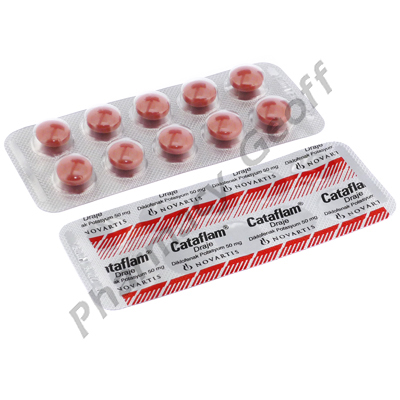Cataflam
Cataflam (Diclofenac) is a nonsteroidal anti-inflammatory drug (NSAID). It is commonly prescribed for those that have mild to moderate arthritis to relieve pain.
What is Cataflam Used for?
Cataflam is used to help with reducing inflammation and pain. The two most common types of arthritis that Cataflam is prescribed for are osteoporosis and rheumatoid arthritis. For some women that suffer from extreme cramping during their menstrual cycle, Cataflam may offer them some relief.
Cataflam Dosage & Administration
Your doctor will start you on the lowest possible dose of Cataflam. Monitoring your progress over time, it may be necessary to increase the amount. This will be done so sparingly though as health risks and side effects increase as the dosage is increased. Never take more of than your doctor has prescribed for you.
This is a daily medicine so donít skip doses even if you are feeling better. Only stop taking it under the advice of your doctor. It is important for your liver to be tested before you begin taking Cataflam. It should also be tested at regular intervals to make sure that damage isnít occurring due to the medication.
Cataflam Side Effects & Precautions
The biggest risk associated with the use of Cataflam is that it can increase the risk of heart problems and circulation concerns. Individuals that already have such problems arenít a good candidate for Cataflam. Such risks are usually the result of long term use. Older adults are at risk of bleeding in the stomach from prolonged use of Cataflam. Consuming alcohol while taking this product increases the risk of such stomach bleeding. Avoid too much exposure to UV rays including indoor tanning.
Make sure you tell your doctor about any prescription or over the counter products you use. Many of them including cough syrups wonít mix well with Cataflam. Even herbal products can be a concern so fully disclose anything that you use. Individuals with kidney problems, liver problems, asthma, or stomach ulcers arenít good candidates for the use of Cataflam. Women can take Cataflam while pregnant, but not in the last 3 months as that can cause harm to the fetus. It isnít to be taken while breastfeeding.
There could be some side effects experienced while taking Cataflam. They include:
- Bloating
- Constipation
- Diarrhea
- Dry Mouth
- Headache
- Insomnia
- Nervousness
- Upset Stomach
Seek immediate medical attention if you experience any of the following:
- Bloody Stools
- Blurred Vision
- Chest Pain
- Coughing up blood
- Ringing in the ears
- Vomiting what looks like coffee grounds
- Yellowing of the skin (Jaundice)
|






